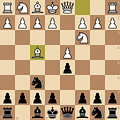Rapid Game Recap: Cameron Park Classic Round 4
The final round of a quick-rated chess tournament
It’s the final game of the tournament. So far I am 2-1 vs 1000-rated opposition that must be stronger than their ratings. Can I win the final round and possibly get some entry fee back? My opponent is a regular at the Sacramento Chess Club. We’ve maybe played a casual game over the board. Last time, it was something slow. This time, he wanted a fight.
Time Control: 15 minutes + 10 second increment
White: 969 USCF
Black: Me (1564 USCF)
1.d4 Nf6 2.Nc3 d5 3.Bf4
In game 2, I played against the Richter-Veresov, but I think the Jobava London is probably a bit better. Here we go.
3…c5 4.e4
I know this is a known move, and to a certain extent, it reminds me of the Blackmar-Diemer Gambit (which White could have played on move three here with 3.e4, though Black could ostensibly transpose to the French with 3…e6). Here it seems much stronger, and more forcing in the center (especially compared to 4.e3). I ought to study this line a bit more, but I figure that Black should be fine with accurate play.
4…dxe4!?
The other line I considered was 4…cxd4 — this is
’s suggestion in his excellent Chessable course The Benko Blueprint: From Theory to Practice. I’m surprised to find that 4…Nxe4 is the main line here. It leads to what looks like an equal endgame, but Hans Niemann has multiple wins as White in the Lichess master’s database after 5.Nxe4 dxe4 6.dxc5 Qxd1+ 7.Rxd15.Bb5+?
I mark this as a mistake. It’s not the worst choice, but I think in a situation like this White should not be inviting trades or allowing Black to develop for free. The move I expected was 5.d5, picking up space and controlling c6. After 5.dxc5 I was thinking of 5…Qa5.
5…Bd7
Once the bishops are traded, Black should have a great game.
6.dxc5 Qa5 7.Bxd7 Nbxd7 8.Bd2
After this passive move, I felt that I was not only winning material but the psychological aspect of the game.
8…Qxc5
This is just a plain pawn plus.
9.Qe2 Qc6
Simply holding the pawn. I felt rather comfortable here. Another idea I found in analysis was 9…e6 10.Nxe4 Nxe4 11.Qxe4 Bd6 12.Qxb7 Rb8, which is still rather comfortable. Black wins back the pawn on b2 and has a comfortable position in the middlegame with active pieces.
10.f3
My opponent basically offers a gambit. In my view this is just a poor version of the Blackmar-Diemer Gambit for White with the bishops off the board. However, I was concerned my opponent could get some initiative on the f-file, typical of the BDG.
10…exf3 11.Nxf3 e6 12.O-O-O Bc5 13.Be3 O-O
13…Bxe3 14.Qxe3 Qc5 would be similar to the game.
14.h3?!
Indicating an ill-conceived plan to attack.
14…Bxe3+ 15.Qxe3
15…Qc5?!
15…b5 was something I considered and was probably much stronger.
16.Qe2?!
16.Qxc5 Nxc5 White is down a pawn, but would have drawing chances.
16…Rac8 17.Kb1 a6 18.Rd2 b5 19.Rhd1 Nb6 20.Ne4 Nxe4 21.Qxe4 Nc4
This is a great square for the knight and threatens to win the exchange.
22.Rd3 h6 23.g4 Rfe8
This covers the e6 pawn, thereby preparing f5.
24.h4?!
My opponent continues his attack.
24...f5?!
24…Qb4! was very strong. After 25.Rb3, I couldn’t see the follow-up: 25…Na3+! 26.Rxa3 Qxe4, winning the queen; so I went for continuing to stop my opponent’s plan instead.
25.gxf5 exf5 26.Qd5+??
Falling to an elementary tactic. 26.Qd4 Qxd4 27.Rxd4 Re2, continuing the attack, was my plan.
26…Qxd5 27.Rxd5 Ne3 0-1
Full gif of the game:
In the end I scored 3/4, won back $30 (sharing 2nd place), and lost 30 rating points. It was a fun tournament and I really enjoyed supporting the new effort to get more chess in more places in the Sacramento area, and am looking forward to the next set of tournaments when I get a chance to compete!
Nick











